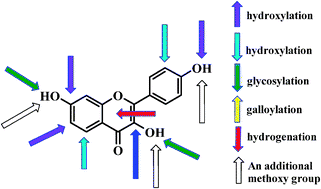Non-covalent interaction of dietary polyphenols with total plasma proteins of type II diabetes: molecular structure/property–affinity relationships
Abstract
The molecular structure/property–affinity relationships of dietary ![[double bond, length as m-dash]](https://www.rsc.org/images/entities/char_e001.gif) C3 double bond of
C3 double bond of

Maintenance work is planned from 09:00 BST to 12:00 BST on Saturday 28th September 2024.
During this time the performance of our website may be affected - searches may run slowly, some pages may be temporarily unavailable, and you may be unable to access content. If this happens, please try refreshing your web browser or try waiting two to three minutes before trying again.
We apologise for any inconvenience this might cause and thank you for your patience.
* Corresponding authors
a
Department of Biology, College of Life & Environment Science, Shanghai Normal University, 100 Guilin Rd, Shanghai 200234, PR China
E-mail:
jianboxiao@yahoo.com, gykai@shnu.edu.cn
Fax: +86 (021)64321291
Tel: +86 13611600163
b Shanghai Dahua Hospital, Shanghai 200237, China
The molecular structure/property–affinity relationships of dietary ![[double bond, length as m-dash]](https://www.rsc.org/images/entities/char_e001.gif) C3 double bond of
C3 double bond of

 Please wait while we load your content...
Something went wrong. Try again?
Please wait while we load your content...
Something went wrong. Try again?
 Fetching data from CrossRef.
Fetching data from CrossRef.
This may take some time to load.
Loading related content
